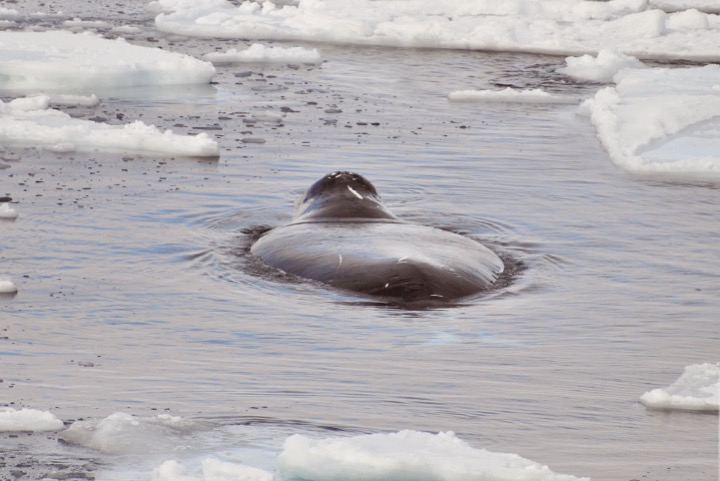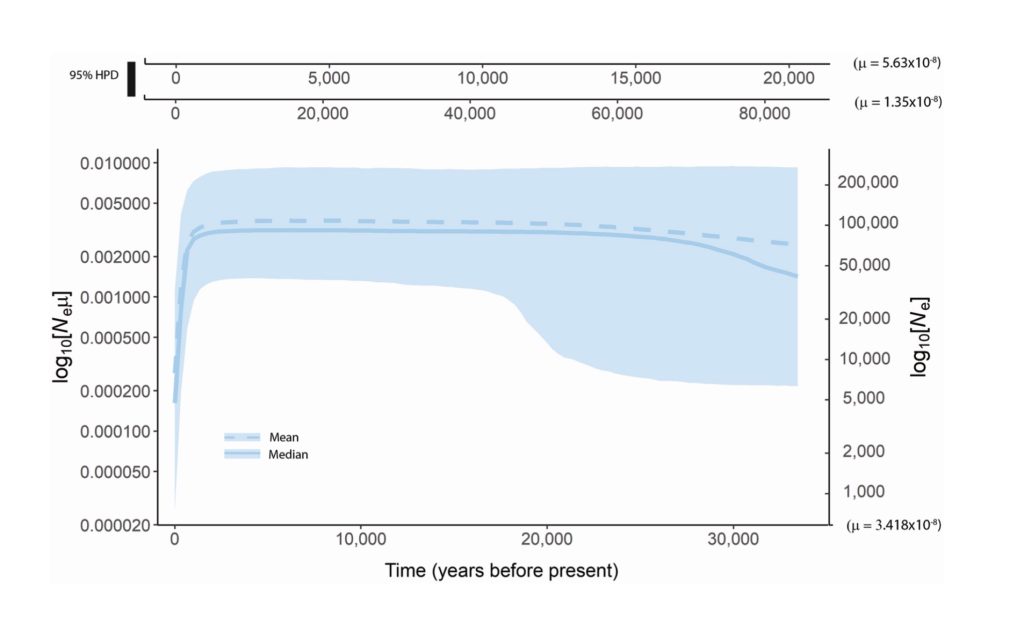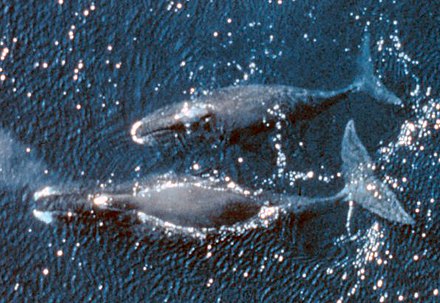Bowhead whales (scientific name Balaena mysticetus) are baleen whales that spend the entire life in the Arctic and subarctic waters. They are named after their characteristic triangular skull that allows them to break through ice for breathing. They are 15-20 meters long and may weigh up to 100 tons.
Bowhead whales have been hunted for centuries, and the four recognized stocks have been depleted. The East Greenland-Svalbard-Barents Sea (EGSB) stock of and is currently listed as Endangered by the International Union of Conservation of Nature (IUCN). It remains an open question to what extent the EGSB stock represents a biological entity that is differentiated from the other bowhead whale stocks.

Researchers of the FEZ group at NHM have a long history of research on EGSB bowhead whales that in recent years increasingly included molecular genetic approaches that were used to reconstruct population history. A prerequisite for such studies is the availability of material. While expeditions in the years 2006, 2008, and 2010 only delivered a handful of skin biopsy samples more recent expeditions conducted by colleagues from the Norwegian Polar Institute delivered were slightly more successful and provided sufficient material for targeting population structure and demography by analyzing genomic diversity.
In 2021 we published a first study focusing on genetic diversity data based on the analyses of mitochondrial genomes. We showed that the EGSB stock has retained noticeable amounts of mitochondrial genome diversity despite extreme historical harvest levels. Furthermore, we traced a slight population growth during the Pleistocene 25 000–35 000 years ago followed by a decline during the Holocene. We detected noticeable genetic differentiation between all extant bowhead whale populations across the circumpolar Arctic, and concluded that the EGSB bowhead whales can be regarded as a population with its own genetic legacy.

Extended genomic studies have now been summarized in a further scientific publication entitled ‘High genomic diversity in the endangered East Greenland-Svalbard-Barents Sea stock of bowhead whales (Balaena mysticetus)’ that supported the conclusions from the previous publication on the demographic history. The study also revealed that despite the small population size, autosome-wide heterozygosity (an indicator of genetic diversity) was higher than that of most mammals for which comparative data are available. The study has been submitted to a scientific journal. We are currently waiting for the comments by international peer-reviewers to be returned.
The specific genetic legacy of the EGSB stock is certainly very important information for the management of the stock. However, similar genomic studies on the other bowhead whale stocks are still lacking; and, the EGSB data are for the time being first of all baseline information for a future more comprehensive assessment of bowhead whale genetic diversity.
Øystein Wiig and Lutz Bachmann from the FEZ group were also co-authoring a multi authors study entitled ‘Strong and lasting impacts of past global warming on baleen whales and their prey’ that was led by colleagues from the University of Groningen, The Netherlands, and the University of Copenhagen, Denmark. The study targeted the effects of the warming period after the Last Glacial Maximum (LGM) on baleen whale (including the bowhead whale) and their prey species (fish and invertebrates) across the Southern and the North Atlantic Oceans. There was a global increase in baleen whale abundance during the Holocene that was associated with simultaneous changes in their prey and climate. Perhaps most important was the observation that the ocean-wide demographic expansions and decreases initiated by the post-LGM global warming continued for millennia after global temperatures stabilized, reflecting persistent, long-lasting impacts of global warming on marine fauna.
References:
Lutz Bachmann, Andrea A Cabrera, Mads Peter Heide-Jørgensen, Olga V Shpak, Christian Lydersen, Øystein Wiig, Kit M Kovacs. Mitogenomics and the genetic differentiation of contemporary Balaena mysticetus (Cetacea) from Svalbard. Zoological Journal of the Linnean Society, Volume 191, Pages 1192-1203. https://doi.org/10.1093/zoolinnean/zlaa082
José Cerca, Michael V. Westbury, Mads Peter Heide-Jørgensen, Kit M. Kovacs, Eline D. Lorenzen, Christian Lydersen, Olga V. Shpak, Øystein Wiig, Lutz Bachmann. High genomic diversity in the endangered East Greenland-Svalbard-Barents Sea stock of bowhead whales (Balaena mysticetus). submitted
Andrea A. Cabrera, Elena Schall, Martine Bérubé, Pia Anderwald, Lutz Bachmann, Simon Berrow, Peter B. Best, Phillip J. Clapham, Haydée A. Cunha, Luciano Dalla Rosa, Carolina Dias, Kenneth P. Findlay, Tore Haug, Mads Peter Heide-Jørgensen, Rus Hoelzel, Kit M. Kovacs, Scott Landry, Finn Larsen, Xênia Moreira Lopes, Christian Lydersen, David K. Mattila, Tom Oosting, Richard M. Pace III, Chiara Papetti, Angeliki Paspati, Luis A. Pastene, Rui Prieto, Christian Ramp, Jooke Robbins, Richard Sears, Eduardo R. Secchi, Mónica A. Silva, Malene Simon, Gísli Víkingsson, Øystein Wiig, Nils Øien, Per J. Palsbøll. Strong and lasting impacts of past global warming on baleen whales and their prey. Global Change Biology, in press.
![]()
